air suspension NISSAN X-TRAIL 2003 Electronic Repair Manual
[x] Cancel search | Manufacturer: NISSAN, Model Year: 2003, Model line: X-TRAIL, Model: NISSAN X-TRAIL 2003Pages: 3066, PDF Size: 51.47 MB
Page 1 of 3066
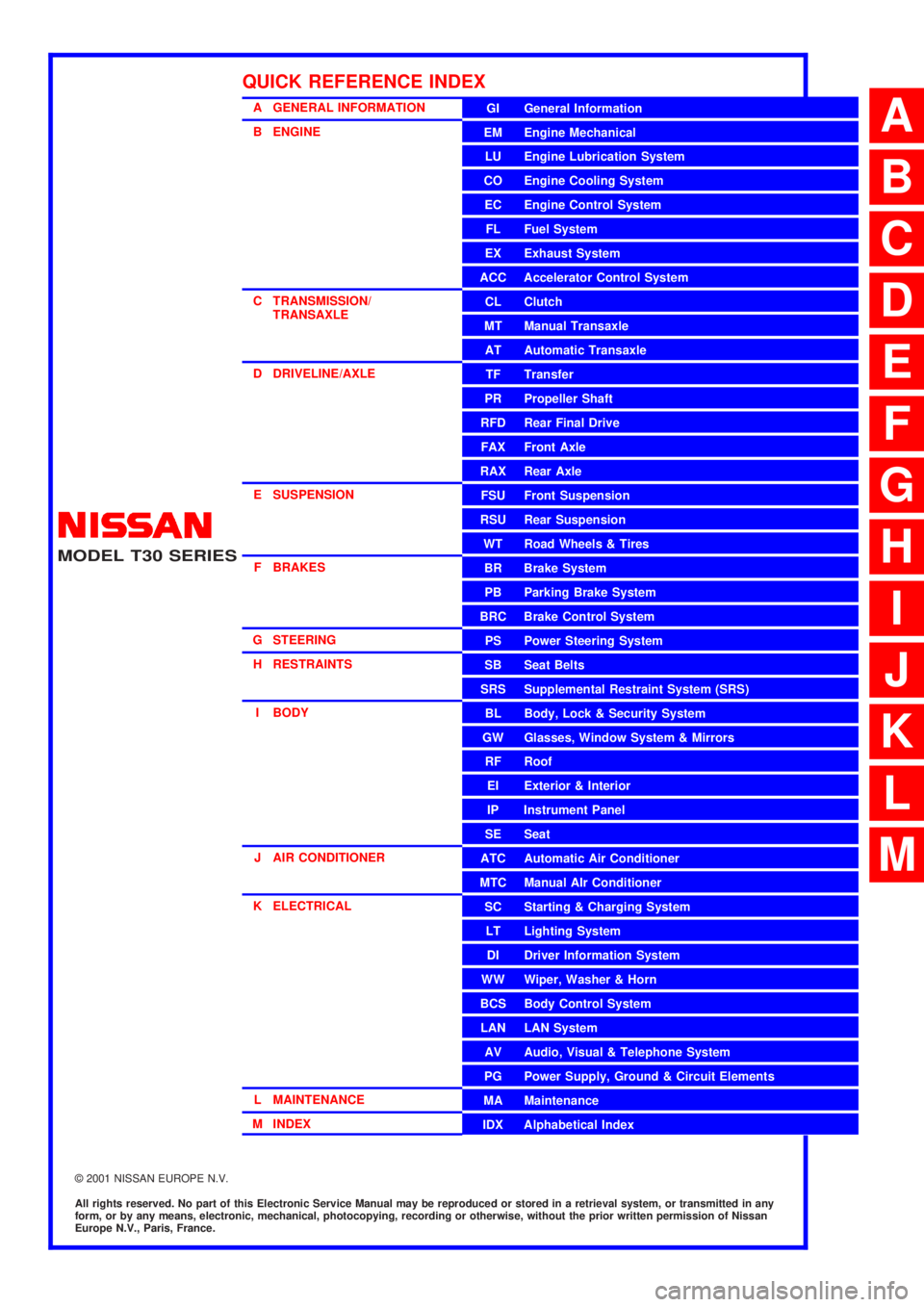
MODEL T30 SERIES
2001 NISSAN EUROPE N.V.
All rights reserved. No part of this Electronic Service Manual may be reproduced or stored in a retrieval system, or transmitted in any
form, or by any means, electronic, mechanical, photocopying, recording or otherwise, without the prior written permission of Nissan
Europe N.V., Paris, France.
A GENERAL INFORMATION
B ENGINE
C TRANSMISSION/
TRANSAXLE
D DRIVELINE/AXLE
E SUSPENSION
F BRAKES
G STEERING
H RESTRAINTS
I BODY
J AIR CONDITIONER
K ELECTRICAL
L MAINTENANCE
M INDEXGI General Information
EM Engine Mechanical
LU Engine Lubrication System
CO Engine Cooling System
EC Engine Control System
FL Fuel System
EX Exhaust System
ACC Accelerator Control System
CL Clutch
MT Manual Transaxle
AT Automatic Transaxle
TF Transfer
PR Propeller Shaft
RFD Rear Final Drive
FAX Front Axle
RAX Rear Axle
FSU Front Suspension
RSU Rear Suspension
WT Road Wheels & Tires
BR Brake System
PB Parking Brake System
BRC Brake Control System
PS Power Steering System
SB Seat Belts
SRS Supplemental Restraint System (SRS)
BL Body, Lock & Security System
GW Glasses, Window System & Mirrors
RF Roof
EI Exterior & Interior
IP Instrument Panel
SE Seat
ATC Automatic Air Conditioner
MTC Manual AIr Conditioner
SC Starting & Charging System
LT Lighting System
DI Driver Information System
WW Wiper, Washer & Horn
BCS Body Control System
LAN LAN System
AV Audio, Visual & Telephone System
PG Power Supply, Ground & Circuit Elements
MA Maintenance
IDX Alphabetical Index
QUICK REFERENCE INDEX
A
B
C
D
E
F
G
H
I
J
K
L
M
Page 839 of 3066
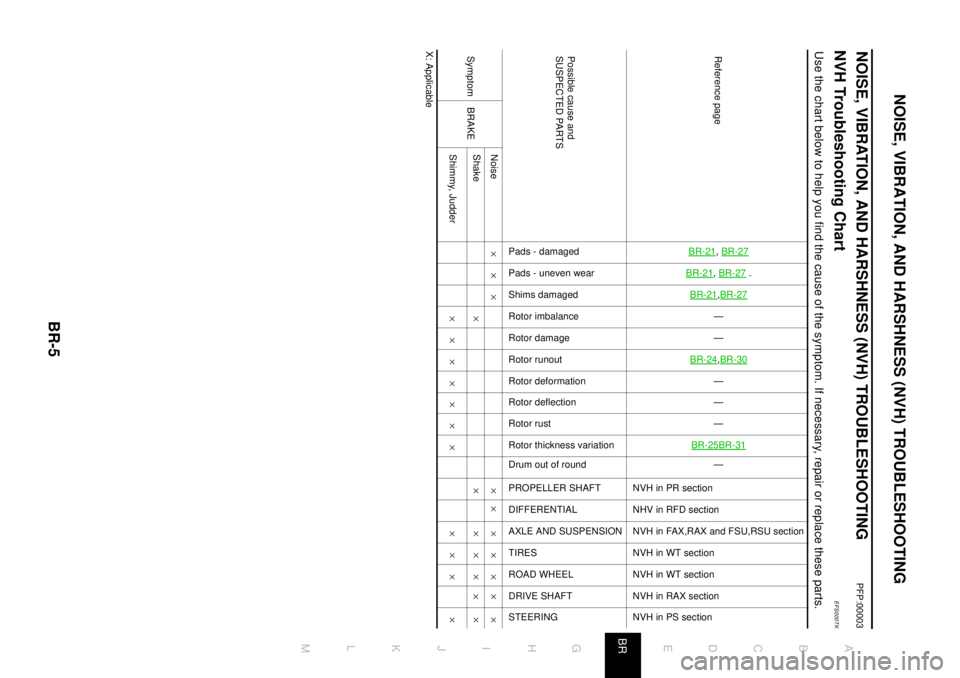
NOISE, VIBRATION, AND HARSHNESS (NVH) TROUBLESHOOTING
BR-5
C
D
E
G
H
I
J
K
L
MA
B
BR
NOISE, VIBRATION, AND HARSHNESS (NVH) TROUBLESHOOTINGPFP:00003
NVH Troubleshooting ChartEFS000TK
Use the chart below to help you find the cause of the symptom. If necessary, repair or replace these parts.
X: ApplicableReference page
BR-21
,BR-27
BR-21
,BR-27
.
BR-21
,BR-27—
—
BR-24,BR-30—
—
—
BR-25BR-31—
NVHinPRsection
NHV in RFD section
NVH in FAX,RAX and FSU,RSU section
NVH in WT section
NVH in WT section
NVH in RAX section
NVH in PS section
Possible cause and
SUSPECTED PARTS
Pads - damaged
Pads - uneven wear
Shims damaged
Rotor imbalance
Rotor damage
Rotor runout
Rotor deformation
Rotor deflection
Rotor rust
Rotor thickness variation
Drum out of round
PROPELLER SHAFT
DIFFERENTIAL
AXLE AND SUSPENSION
TIRES
ROAD WHEEL
DRIVE SHAFT
STEERING
Symptom BRAKENoise´´´ ´´ ´´´
´´
Shake´ ´ ´´´
´´
Shimmy, Judder´´´´´´´ ´´´ ´
Page 956 of 3066
![NISSAN X-TRAIL 2003 Electronic Repair Manual BRC-88
[ESP/TCS/ABS]
TROUBLE DIAGNOSIS
For Correct and Quick Diagnosis
EFS001A8
PRECAUTIONS FOR TROUBLE DIAGNOSIS
lBefore performing the trouble diagnosis, always read theGI-3, "PRECAUTIONS"to confirm NISSAN X-TRAIL 2003 Electronic Repair Manual BRC-88
[ESP/TCS/ABS]
TROUBLE DIAGNOSIS
For Correct and Quick Diagnosis
EFS001A8
PRECAUTIONS FOR TROUBLE DIAGNOSIS
lBefore performing the trouble diagnosis, always read theGI-3, "PRECAUTIONS"to confirm](/img/5/57402/w960_57402-955.png)
BRC-88
[ESP/TCS/ABS]
TROUBLE DIAGNOSIS
For Correct and Quick Diagnosis
EFS001A8
PRECAUTIONS FOR TROUBLE DIAGNOSIS
lBefore performing the trouble diagnosis, always read theGI-3, "PRECAUTIONS"to confirm the general
precautions.
lAfter replacement of ESP/TCS/ABS control unit, steering angle sensor, steering parts, suspension parts,
or tires, and adjustment of alignment, always adjust the neutral position of steering angle sensor before
driving.
lWhen the ESP/TCS/ABS control unit is replaced, check that the label on the computer unit is identical
color.
lAfter completing the trouble diagnosis, always erase the malfunctioning memory.BRC-77, "Functions of
CONSULT-II"
lWhen inspection of the continuity or voltage between units is performed, check the connector terminals for
disconnection, looseness, bend, or collapse. If any malfunction is detected, repair or replace the applica-
ble part.
lIntermittent problems may be caused by a malfunction on harness, connector, or terminal. Move the har-
nesses, harness connectors, or terminals by hand to make sure that there is no contact malfunction.
lIf a circuit tester is used for the check, be careful not to forcibly extend any connector terminal.
lFor self-diagnosis, active test, and work support of ESP/TCS/ABS control unit with CONSULT-II, stop and
connect CONSULT-II and select²ABS².
lCONSULT-II self-diagnosis results are displayed without regard to occurrence timing. In some case, the
later ones (timing value is small) appear on the next screen.
lWhile the self-diagnosis results of CONSULT-II shows a malfunction, if CONSULT-II active test is per-
formed, an engine system malfunction may be indicated. In this case, start the engine to resume the nor-
mal screen.
lESP/TCS/ABS system electronically controls the brake operation and engine output. The following symp-
toms may be caused by the normal operations.
Symptom Symptom description Result
Motor operation noiseDuring ESP, TCS, or ABS operation, sometimes a faint noise can be
heard. This is a motor operation noise in the ESP/TCS/ABS actuator.
Normal
Just after the engine starts, the motor operating noise may be heard.
This is a normal status of the system operation check.
System operation check
noiseWhen the engine starts, a²click²noise may be heard from the engine
compartment. This is a normal status of the system operation check.Normal
ESP/TCS operation
(SLIP lamp ON)When the vehicle is passing through a road where the surface friction
coefficient varies or the wheel speed changes suddenly by downshifting
or depressing of the accelerator pedal fully, TCS may be activated tem-
porarily.
Normal
Cancel the ESP/TCS
function for the
inspection on a chas-
sis dynamometer. Before the speedometer inspection, turn ESP OFF switch off to cancel
the ESP/TCS function.
When the accelerator pedal is depressed on a chassis dynamometer,
the vehicle speed will not increase. This is not malfunction, because
TCS is activated by the wheel speed difference between front and rear.
The warning lamp may also illuminate to show²sensor system failure²in
this case. This is not malfunction either, because the stationary front
wheels are detected. Restart the engine, and drive the vehicle at 30 km/
h or higher to check that the warning lamp no longer illuminates.
ABS operation (Longer stop-
ping distance)The stopping distance may be longer for the vehicles with ABS when the
vehicle is driver on snowy and rough road. When driving on the road like
that, slow down the speed.Normal
Sluggish feelDepending on road circumstances, the driver may have a sluggish feel.
This is not abnormal, because the optimum traction has the highest pri-
ority (safety first) by TCS operation. Sometimes the driver has a slight
sluggish feel against the substantial accelerator pedal operation.Normal
Page 2032 of 3066
![NISSAN X-TRAIL 2003 Electronic Repair Manual EM-62
[QR20DE]
ENGINE ASSEMBLY
1. Release fuel pressure. Refer toEC-34, "FUEL PRESSURE RELEASE"(WITH EURO-OBD),EC-399,
"FUEL PRESSURE RELEASE"(WITHOUT EURO-OBD).
2. Remove engine hood.
3. Drain coolan NISSAN X-TRAIL 2003 Electronic Repair Manual EM-62
[QR20DE]
ENGINE ASSEMBLY
1. Release fuel pressure. Refer toEC-34, "FUEL PRESSURE RELEASE"(WITH EURO-OBD),EC-399,
"FUEL PRESSURE RELEASE"(WITHOUT EURO-OBD).
2. Remove engine hood.
3. Drain coolan](/img/5/57402/w960_57402-2031.png)
EM-62
[QR20DE]
ENGINE ASSEMBLY
1. Release fuel pressure. Refer toEC-34, "FUEL PRESSURE RELEASE"(WITH EURO-OBD),EC-399,
"FUEL PRESSURE RELEASE"(WITHOUT EURO-OBD).
2. Remove engine hood.
3. Drain coolant from radiator drain plug.
4. Remove the following parts.
lLH/RH under cover
lLH/RH Front wheel
lBattery
lAuxiliary drive belt; Refer toEM-14, "Removal and Installation of Auxiliary Drive Belt Auto- tensioner".
lAir duct and air cleaner case assembly; Refer toEM-15, "Removal and Installation".
lAlternator
lRadiator and radiator fan assembly; Refer toCO-12, "RADIATOR".
5. Disconnect engine room harness from the engine side and set it aside for easier work.
6. Disconnect all the body-side vacuum hoses and air hoses at engine side.
Engine room LH
7. Disconnect fuel hose, and plug it to prevent fuel from draining. Refer toEM-17, "
INTAKE MANIFOLD"
8. Disconnect heater hose, and install plug it to prevent engine coolant from draining.
9. Disconnect select cable from transaxle (A/T models).
10. Remove clutch operating cylinder from transaxle, and move it aside (M/T models).
11. Disconnect shift cable from transaxle (M/T models).
Engine room RH
12. Remove engine coolant reservoir tank.
13. Remove air conditioner compressor with piping connected from engine. Temporarily secure it on body
with a rope to avoid putting load on it.
Vehicle underbody
14. Remove exhaust front tube.
15. Remove propeller shaft.
16. Remove steering shaft from steering gear.
17. Disconnect power steering fluid cooler piping at a point between body and engine.
18. Remove ABS sensor from brake caliper.
19. Remove brake caliper with piping connected from steering knuckle. Temporarily secure it on body with a
rope to avoid load on it.
20. Remove LH/RH suspension from steering knuckle under strut.
Removal
21. Install engine slingers into front left of cylinder head and rear right of cylinder head.
lUse alternator bracket mounting bolt holes for the frontside.
22. Lift with hoist and secure the engine in position.Slinger bolts:
Front: 51.0 - 64.7 N·m (5.2 - 6.6 kg-m, 38 - 47 ft-lb)
Rear: 24.5 - 31.4 N·m (2.5 - 3.2 kg-m, 18 - 23 ft-lb)
KBIA0255E
Page 2033 of 3066
![NISSAN X-TRAIL 2003 Electronic Repair Manual ENGINE ASSEMBLY
EM-63
[QR20DE]
C
D
E
F
G
H
I
J
K
L
MA
EM
lUse a manual lift table caddy or equivalently rigid tool such as a
jack or trestle. Securely support bottom of engine and transaxle,
and simul NISSAN X-TRAIL 2003 Electronic Repair Manual ENGINE ASSEMBLY
EM-63
[QR20DE]
C
D
E
F
G
H
I
J
K
L
MA
EM
lUse a manual lift table caddy or equivalently rigid tool such as a
jack or trestle. Securely support bottom of engine and transaxle,
and simul](/img/5/57402/w960_57402-2032.png)
ENGINE ASSEMBLY
EM-63
[QR20DE]
C
D
E
F
G
H
I
J
K
L
MA
EM
lUse a manual lift table caddy or equivalently rigid tool such as a
jack or trestle. Securely support bottom of engine and transaxle,
and simultaneously adjust hoist tension.
CAUTION:
lPut a piece of wood or something similar as the support-
ing surface, secure a completely stable condition.
23. Remove RH engine mounting insulator.
24. Pull LH engine mounting through-bolt out.
25. Remove mounting bolts at front end of center member.
26. Remove front suspension member mounting bolts and nuts.
27. Remove engine, transaxle and transfer assembly with suspen-
sion member from vehicle downward by carefully operating sup-
porting tools.
CAUTION:
lDuring the operation, make sure that no part interferes
with body side.
lBefore and during this lifting, always check if any har-
nesses are left connected.
lDuring the removal operation, always be careful to pre-
vent vehicle from falling off the lift due to changes in the center of gravity.
lIf necessary, support vehicle by setting a jack or equivalent tool at the rear.
28. Remove power steering pump with piping connected from engine. Move it aside on suspension member.
29. Remove front engine mounting and rear engine mounting through-bolts to remove suspension member.
30. Remove starter motor.
31. Separate engine and transaxle.
INSTALLATION
Install in the reverse order of removal.
lDo not allow oil to get on mounting insulator. Be careful not to damage mounting insulator.
lWhen installation directions are specified, install parts according to the direction marks on them referring
to components illustration.
lMake sure that each mounting insulator is seated properly, and tighten mounting bolts and nuts.
INSPECTION AFTER INSTALLATION
lBefore starting engine check the levels of coolant, lubrications and working oils. If less than required
quantity, fill to the specified level.
lRun engine to check for unusual noise and vibration.
lWarm up engine thoroughly to make sure there is no leakage of coolant, lubricants, working oil, fuel and
exhaust gas.
lBleed air from passages in pipes and tubes of applicable lines.
KBIA0256E
KBIA0257E
KBIA0270E
Page 2155 of 3066
![NISSAN X-TRAIL 2003 Electronic Repair Manual ENGINE ASSEMBLY
EM-185
[YD22DDTi]
C
D
E
F
G
H
I
J
K
L
MA
EM
1. Remove engine hood.
2. Drain coolant from radiator drain plug.
3. Remove the following parts.
lLH/RH under cover
lLH/RH front wheel
lBatt NISSAN X-TRAIL 2003 Electronic Repair Manual ENGINE ASSEMBLY
EM-185
[YD22DDTi]
C
D
E
F
G
H
I
J
K
L
MA
EM
1. Remove engine hood.
2. Drain coolant from radiator drain plug.
3. Remove the following parts.
lLH/RH under cover
lLH/RH front wheel
lBatt](/img/5/57402/w960_57402-2154.png)
ENGINE ASSEMBLY
EM-185
[YD22DDTi]
C
D
E
F
G
H
I
J
K
L
MA
EM
1. Remove engine hood.
2. Drain coolant from radiator drain plug.
3. Remove the following parts.
lLH/RH under cover
lLH/RH front wheel
lBattery
lAuxiliary drive belt; Refer toE M - 111 , "Removal and Installation".
lAir duct and air cleaner case assembly; Refer toEM-112, "Removal and Installation".
lAlternator
lRadiator and radiator fan assembly; Refer toCO-33, "Removal and Installation".
lCharge air cooler
4. Disconnect engine room harness from the engine side and set it aside for easier work.
5. Disconnect all the body-side vacuum hoses and air hoses at engine side.
Engine room LH
6. Disconnect fuel feed and return hoses, and plug it to prevent fuel from draining.
7. Disconnect heater hose, and install plug it to prevent engine coolant from draining.
8. Remove clutch operating cylinder from transaxle, and move it aside.
9. Disconnect shift cable from transaxle.
Engine room RH
10. Remove engine coolant reservoir tank.
11. Remove air conditioner compressor with piping connected from engine. Temporarily secure it on body
with a rope to avoid putting load on it.
Vehicle underbody
12. Remove exhaust front tube.
13. Remove propeller shaft.
14. Remove steering shaft from steering gear.
15. Disconnect power steering fluid cooler piping at a point between body and engine.
16. Remove ABS sensor from brake caliper.
17. Remove brake caliper with piping connected from steering knuckle. Temporarily secure it on body with a
rope to avoid load on it.
18. Remove LH/RH suspension from steering knuckle under strut.
Removal
19. Install engine slingers into front right of cylinder head and rear
left of cylinder head.
20. Liftwithhoistandsecuretheengineinposition.Slinger bolts:
: 30 - 37 N·m (3.0 - 3.8 kg-m, 22 - 27 ft-lb)
SBIA0191E
Page 2156 of 3066
![NISSAN X-TRAIL 2003 Electronic Repair Manual EM-186
[YD22DDTi]
ENGINE ASSEMBLY
lUse a manual lift table caddy or equivalently rigid tool such as a
jack or trestle. Securely support bottom of engine and transaxle,
and simultaneously adjust hoist NISSAN X-TRAIL 2003 Electronic Repair Manual EM-186
[YD22DDTi]
ENGINE ASSEMBLY
lUse a manual lift table caddy or equivalently rigid tool such as a
jack or trestle. Securely support bottom of engine and transaxle,
and simultaneously adjust hoist](/img/5/57402/w960_57402-2155.png)
EM-186
[YD22DDTi]
ENGINE ASSEMBLY
lUse a manual lift table caddy or equivalently rigid tool such as a
jack or trestle. Securely support bottom of engine and transaxle,
and simultaneously adjust hoist tension.
CAUTION:
Put a piece of wood or something similar as the supporting
surface, secure a completely stable condition.
21. Remove RH engine mounting insulator.
22. Pull LH engine mounting through-bolt out.
23. Remove mounting bolts at front end of center member.
24. Remove front suspension member mounting bolts and nuts.
25. Remove engine, transaxle and transfer assembly with suspen-
sion member from vehicle downward by carefully operating sup-
porting tools.
CAUTION:
lDuring the operation, make sure that no part interferes
with body side.
lBefore and during this lifting, always check if any har-
nesses are left connected.
lDuring the removal operation, always be careful to pre-
vent vehicle from falling off the lift due to changes in the center of gravity.
lIf necessary, support vehicle by setting a jack or equivalent tool at the rear.
26. Remove power steering pump with piping connected from engine. Move it aside on suspension member.
27. Remove front engine mounting and rear engine mounting through-bolts to remove suspension member.
28. Remove starter motor.
29. Separate engine and transaxle.
INSTALLATION
Install in the reverse order of removal.
lDo not allow oil to get on mounting insulator. Be careful not to damage mounting insulator.
lWhen installation directions are specified, install parts according to the direction marks on them referring
to components illustration.
lMake sure that each mounting insulator is seated properly, and tighten mounting bolts and nuts.
INSPECTION AFTER INSTALLATION
lBefore starting engine check the levels of coolant, lubrications and working oils. If less than required
quantity, fill to the specified level.
lBefore starting engine, bleed air from fuel piping. Refer toFL-16, "Air Bleeding".
lRun engine to check for unusual noise and vibration.
lWarm up engine thoroughly to make sure there is no leakage of coolant, lubricants, working oil, fuel and
exhaust gas.
KBIA0256E
KBIA0257E
KBIA0270E
Page 2198 of 3066
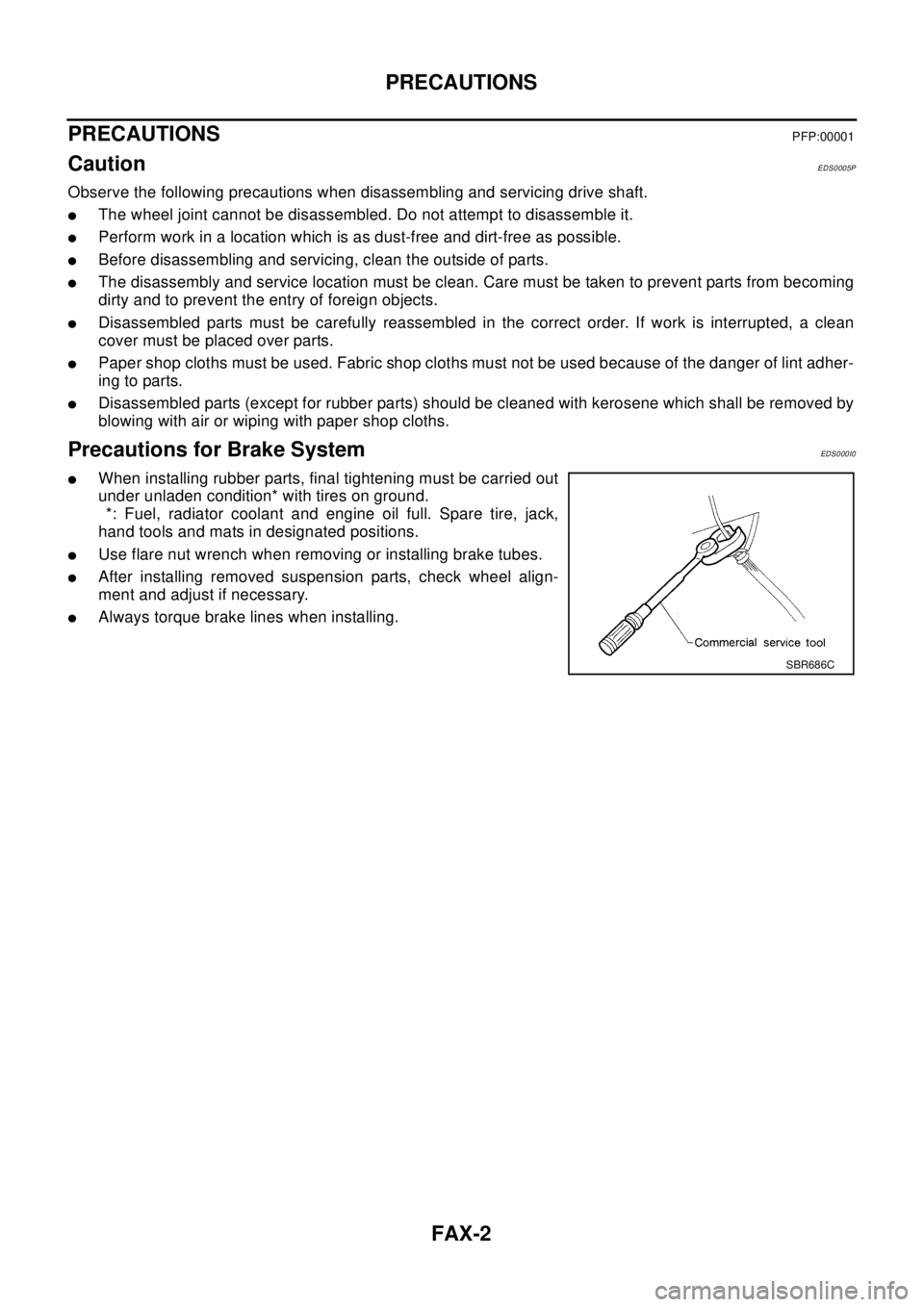
FAX-2
PRECAUTIONS
PRECAUTIONS
PFP:00001
CautionEDS0005P
Observe the following precautions when disassembling and servicing drive shaft.
lThe wheel joint cannot be disassembled. Do not attempt to disassemble it.
lPerform work in a location which is as dust-free and dirt-free as possible.
lBefore disassembling and servicing, clean the outside of parts.
lThe disassembly and service location must be clean. Care must be taken to prevent parts from becoming
dirty and to prevent the entry of foreign objects.
lDisassembled parts must be carefully reassembled in the correct order. If work is interrupted, a clean
cover must be placed over parts.
lPaper shop cloths must be used. Fabric shop cloths must not be used because of the danger of lint adher-
ing to parts.
lDisassembled parts (except for rubber parts) should be cleaned with kerosene which shall be removed by
blowing with air or wiping with paper shop cloths.
Precautions for Brake SystemEDS0 00 I0
lWhen installing rubber parts, final tightening must be carried out
under unladen condition* with tires on ground.
*: Fuel, radiator coolant and engine oil full. Spare tire, jack,
hand tools and mats in designated positions.
lUse flare nut wrench when removing or installing brake tubes.
lAfter installing removed suspension parts, check wheel align-
ment and adjust if necessary.
lAlways torque brake lines when installing.
SBR686C
Page 2243 of 3066
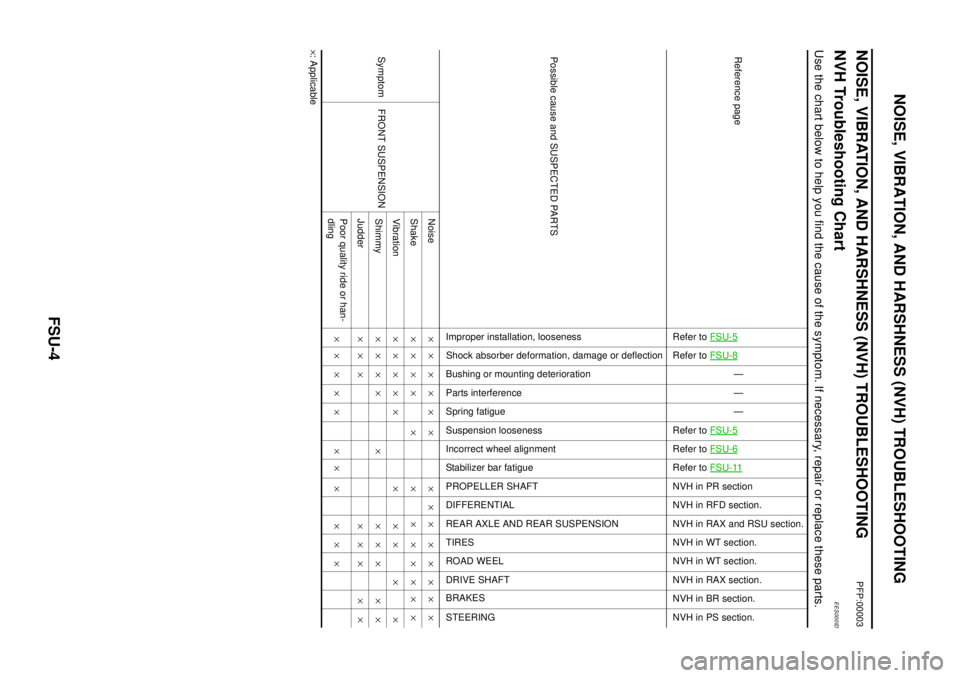
FSU-4
NOISE, VIBRATION, AND HARSHNESS (NVH) TROUBLESHOOTING
NOISE, VIBRATION, AND HARSHNESS (NVH) TROUBLESHOOTING
PFP:00003
NVH Troubleshooting ChartEES000ID
Use the chart below to help you find the cause of the symptom. If necessary, repair or replace these parts.
´: ApplicableReference page
Refer toFSU-5Refer toFSU-8
—
—
—
Refer toFSU-5
Refer toFSU-6Refer toFSU-11NVH in PR section
NVH in RFD section.
NVHinRAXandRSUsection.
NVH in WT section.
NVH in WT section.
NVH in RAX section.
NVH in BR section.
NVH in PS section.
Possible cause and SUSPECTED PARTS
Improper installation, looseness
Shock absorber deformation, damage or deflection
Bushing or mounting deterioration
Parts interference
Spring fatigue
Suspension looseness
Incorrect wheel alignment
Stabilizer bar fatigue
PROPELLER SHAFT
DIFFERENTIAL
REAR AXLE AND REAR SUSPENSION
TIRES
ROAD WEEL
DRIVE SHAFT
BRAKES
STEERING
Symptom FRONT SUSPENSIONNoise´´´´´ ´ ´´´ ´´´´´
Shake´´´´ ´ ´ ´ ´´´´´
Vibration´´´´´ ´ ´´ ´ ´
Shimmy´´´´ ´ ´´´ ´´
Judder´´´ ´´´ ´´
Poor quality ride or han-
dling´´´´´ ´´ ´ ´´´
Page 2245 of 3066
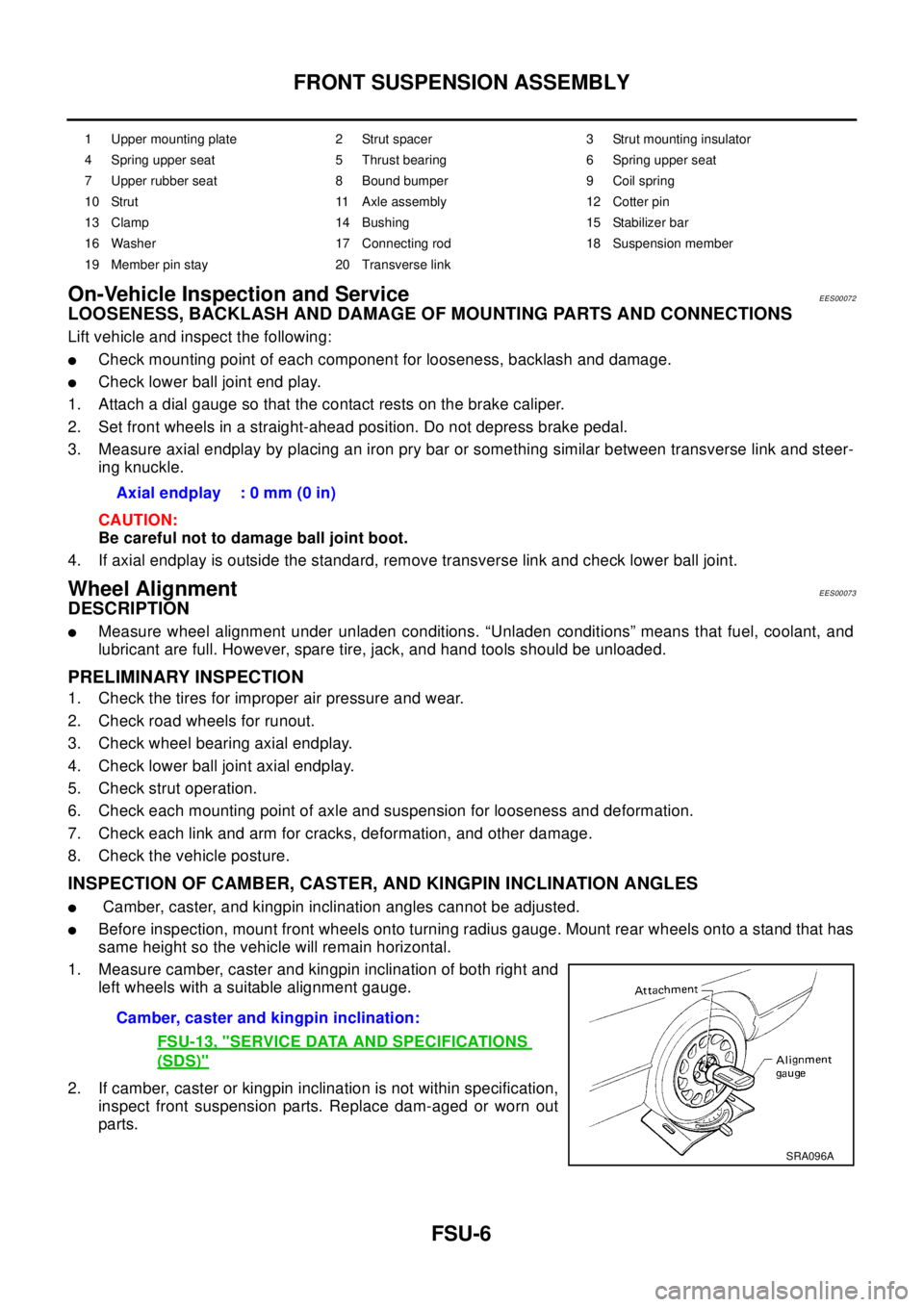
FSU-6
FRONT SUSPENSION ASSEMBLY
On-Vehicle Inspection and Service
EES00072
LOOSENESS, BACKLASH AND DAMAGE OF MOUNTING PARTS AND CONNECTIONS
Lift vehicle and inspect the following:
lCheck mounting point of each component for looseness, backlash and damage.
lCheck lower ball joint end play.
1. Attach a dial gauge so that the contact rests on the brake caliper.
2. Set front wheels in a straight-ahead position. Do not depress brake pedal.
3. Measure axial endplay by placing an iron pry bar or something similar between transverse link and steer-
ing knuckle.
CAUTION:
Be careful not to damage ball joint boot.
4. If axial endplay is outside the standard, remove transverse link and check lower ball joint.
Wheel AlignmentEES00073
DESCRIPTION
lMeasure wheel alignment under unladen conditions. “Unladen conditions” means that fuel, coolant, and
lubricant are full. However, spare tire, jack, and hand tools should be unloaded.
PRELIMINARY INSPECTION
1. Check the tires for improper air pressure and wear.
2. Check road wheels for runout.
3. Check wheel bearing axial endplay.
4. Check lower ball joint axial endplay.
5. Check strut operation.
6. Check each mounting point of axle and suspension for looseness and deformation.
7. Check each link and arm for cracks, deformation, and other damage.
8. Check the vehicle posture.
INSPECTION OF CAMBER, CASTER, AND KINGPIN INCLINATION ANGLES
lCamber, caster, and kingpin inclination angles cannot be adjusted.
lBefore inspection, mount front wheels onto turning radius gauge. Mount rear wheels onto a stand that has
same height so the vehicle will remain horizontal.
1. Measure camber, caster and kingpin inclination of both right and
left wheels with a suitable alignment gauge.
2. If camber, caster or kingpin inclination is not within specification,
inspect front suspension parts. Replace dam-aged or worn out
parts.
1 Upper mounting plate 2 Strut spacer 3 Strut mounting insulator
4 Spring upper seat 5 Thrust bearing 6 Spring upper seat
7 Upper rubber seat 8 Bound bumper 9 Coil spring
10 Strut 11 Axle assembly 12 Cotter pin
13 Clamp 14 Bushing 15 Stabilizer bar
16 Washer 17 Connecting rod 18 Suspension member
19 Member pin stay 20 Transverse link
Axial endplay : 0 mm (0 in)
Camber, caster and kingpin inclination:
FSU-13, "
SERVICE DATA AND SPECIFICATIONS
(SDS)"
SRA096A